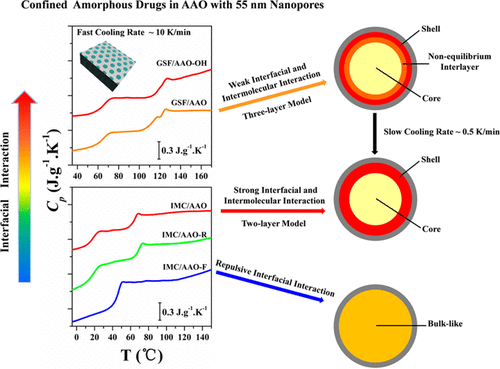当前位置:
X-MOL 学术
›
J. Phys. Chem. B
›
论文详情
Our official English website, www.x-mol.net, welcomes your feedback! (Note: you will need to create a separate account there.)
Nanostructures and Dynamics of Isochorically Confined Amorphous Drug Mediated by Cooling Rate, Interfacial, and Intermolecular Interactions
The Journal of Physical Chemistry B ( IF 3.3 ) Pub Date : 2017-11-17 00:00:00 , DOI: 10.1021/acs.jpcb.7b08545 Chen Zhang 1 , Ye Sha 1 , Yue Zhang 1 , Ting Cai 2 , Linling Li 1 , Dongshan Zhou 1 , Xiaoliang Wang 1 , Gi Xue 1
The Journal of Physical Chemistry B ( IF 3.3 ) Pub Date : 2017-11-17 00:00:00 , DOI: 10.1021/acs.jpcb.7b08545 Chen Zhang 1 , Ye Sha 1 , Yue Zhang 1 , Ting Cai 2 , Linling Li 1 , Dongshan Zhou 1 , Xiaoliang Wang 1 , Gi Xue 1
Affiliation

|
The production and stabilization of amorphous drugs by the nanoconfinement effect has recently become a research hotspot in pharmaceutical sciences. Herein, two guest/host systems, indomethacin (IMC) and griseofulvin (GSF) confined in anodic aluminum oxide (AAO) templates with different pore diameters (25–250 nm) are investigated by differential scanning calorimetry (DSC) and broadband dielectric spectroscopy (BDS). The crystallization of the confined drugs is suppressed, and their glass transition temperatures show an evident pore-size dependency. Moreover, a combination of dielectric and calorimetric results demonstrates that the significant change in the temperature dependence of the structural relaxation time during the cooling process is attributed to the vitrification of the interfacial molecules and the local density heterogeneity under isochoric confinement. Interestingly, compared with the case of IMC/AAO, which can be described by a typical two-layer model, GSF/AAO presents an rare scenario of three glass transition temperatures under fast cooling (40–10 K/min), indicating that there exists a thermodynamic nonequilibrium interlayer between the bulk-like core and interfacial layer. In contrast, the slow cooling process (0.5 K/min) would lead confined GSF into the stable core–shell nanostructure. Using surface modification, the interfacial effect is confirmed to be an important reason for the different phenomena between these two guest/host systems, and intermolecular hydrogen bonding is also suggested to be emphasized considering the long-range effect of interfacial interactions. Our results not only provide insight into the glass transition behavior of geometrically confined supercooled liquids, but also offer a means of adjusting and stabilizing the nanostructure of amorphous drugs under two-dimensional confinement.
中文翻译:

冷却速率,界面和分子间相互作用介导的等时限无定形药物的纳米结构和动力学。
通过纳米约束作用生产和稳定无定形药物近来已成为药学领域的研究热点。在本文中,通过差示扫描量热法(DSC)和宽带介电谱法(DSC)研究了两种客体/宿主系统,吲哚美辛(IMC)和灰黄霉素(GSF)限制在具有不同孔径(25-250 nm)的阳极氧化铝(AAO)模板中BDS)。限制药物的结晶,其玻璃化转变温度显示出明显的孔径依赖性。而且,介电和量热结果的组合表明,在冷却过程中,结构弛豫时间对温度的依赖关系发生了显着变化,这归因于界面分子的玻璃化和等容约束下的局部密度异质性。有趣的是,与可以通过典型的两层模型描述的IMC / AAO相比,GSF / AAO提出了在快速冷却(40–10 K / min)下三种玻璃化转变温度的罕见情况,表明存在在块状芯和界面层之间存在热力学非平衡夹层。相比之下,缓慢的冷却过程(0.5 K / min)会将封闭的GSF引入稳定的核-壳纳米结构。使用表面修饰,界面作用被证实是这两种客体/主体系统之间现象不同的重要原因,并且考虑到界面相互作用的远距离作用,还建议强调分子间氢键。我们的结果不仅可以洞悉几何形状受限的过冷液体的玻璃化转变行为,而且还可以提供一种在二维约束下调节和稳定无定形药物纳米结构的方法。
更新日期:2017-11-19
中文翻译:

冷却速率,界面和分子间相互作用介导的等时限无定形药物的纳米结构和动力学。
通过纳米约束作用生产和稳定无定形药物近来已成为药学领域的研究热点。在本文中,通过差示扫描量热法(DSC)和宽带介电谱法(DSC)研究了两种客体/宿主系统,吲哚美辛(IMC)和灰黄霉素(GSF)限制在具有不同孔径(25-250 nm)的阳极氧化铝(AAO)模板中BDS)。限制药物的结晶,其玻璃化转变温度显示出明显的孔径依赖性。而且,介电和量热结果的组合表明,在冷却过程中,结构弛豫时间对温度的依赖关系发生了显着变化,这归因于界面分子的玻璃化和等容约束下的局部密度异质性。有趣的是,与可以通过典型的两层模型描述的IMC / AAO相比,GSF / AAO提出了在快速冷却(40–10 K / min)下三种玻璃化转变温度的罕见情况,表明存在在块状芯和界面层之间存在热力学非平衡夹层。相比之下,缓慢的冷却过程(0.5 K / min)会将封闭的GSF引入稳定的核-壳纳米结构。使用表面修饰,界面作用被证实是这两种客体/主体系统之间现象不同的重要原因,并且考虑到界面相互作用的远距离作用,还建议强调分子间氢键。我们的结果不仅可以洞悉几何形状受限的过冷液体的玻璃化转变行为,而且还可以提供一种在二维约束下调节和稳定无定形药物纳米结构的方法。



























 京公网安备 11010802027423号
京公网安备 11010802027423号